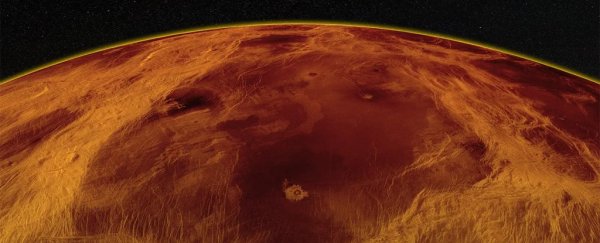Venus may be a toxic hell-planet, but new evidence suggests it might have more in common than Earth than we realized.
Scientists have just found evidence that Venus' crust could have tectonic blocks that rub together, not dissimilar to broken blocks of pack ice. It's not entirely like Earth's plate tectonics, but the discovery does suggest that the planet's crust isn't one globally continuous lithosphere, and that convective motion swirls below.
This doesn't just offer insights into Venus - it could help us better understand the evolution and dynamics of tectonics on early Earth.
"We've identified a previously unrecognized pattern of tectonic deformation on Venus, one that is driven by interior motion just like on Earth," said planetary scientist Paul Byrne of North Carolina State University.
"Although different from the tectonics we currently see on Earth, it is still evidence of interior motion being expressed at the planet's surface."
Earth really is a unique little oddball in the Solar System, in many ways. One of those ways is its system of plate tectonics - shifting scales of crust that grind against each other and overlap (subduct), moving over a hot, molten interior planetary layer.
We don't see this kind of activity on Mercury, or Mars, or the Moon. And nor do we see it on Venus - which is strange, considering the similar sizes and geological compositions of Venus and Earth.
The two planets took quite different evolutionary paths, in spite of their similarities, and the reasons for that are not very well understood. If we can work out how and why Earth and Venus turned, respectively, into a lush, thriving ocean world and a scorching wasteland, we will have a better handle on similar exoplanets, out there in the wider galaxy.
Byrne and his team were mapping the surface of Venus, using radar images taken by NASA's Magellan probe in the 1990s. They noticed that, in the lowlands, some features seem to suggest large-scale movement - shear stresses and deformations from the motions and interactions of large blocks of crust.
To figure out if what they were seeing was what they thought they were seeing, the team performed modeling. They found that convective flow beneath the crust of Venus could produce the observed features, if the crust was broken up into large chunks, rather than plates.
"Plate tectonics on Earth are driven by convection in the mantle. The mantle is hot or cold in different places, it moves, and some of that motion transfers to Earth's surface in the form of plate movement," Byrne explained.
"A variation on that theme seems to be playing out on Venus as well. It's not plate tectonics like on Earth - there aren't huge mountain ranges being created here, or giant subduction systems - but it is evidence of deformation due to interior mantle flow, which hasn't been demonstrated on a global scale before."
Recent evidence also suggests that Venus may still be volcanically active. A study released last year found that volcanic features on the planet's surface are relatively recent. We also know that most of the planet has been volcanically resurfaced in the last billion years or so.
In order to produce the features Byrne's team observed, the tectonic hijinks must have taken place after the resurfacing. This suggests that, not only is this activity relatively recent, it may still be ongoing.
This suggests an intermediate stage of tectonic activity, on a continuum between the fixed global shells of Mercury, Mars, and the Moon, and the mobility of Earth's flimsier tectonic plates. This could help us better understand exoplanets in the 'Venus zone' of orbit around their host stars, and the interiors of rocky planets.
It also might offer some insight into the tectonic processes on early Earth.
"The thickness of a planet's lithosphere depends mainly upon how hot it is, both in the interior and on the surface," Byrne said.
"Heat flow from the young Earth's interior was up to three times greater than it is now, so its lithosphere may have been similar to what we see on Venus today: not thick enough to form plates that subduct, but thick enough to have fragmented into blocks that pushed, pulled, and jostled."
Future observations by upcoming Venus missions by NASA and the European Space Agency will tell us more about this fascinating discovery.
The research has been published in PNAS.
